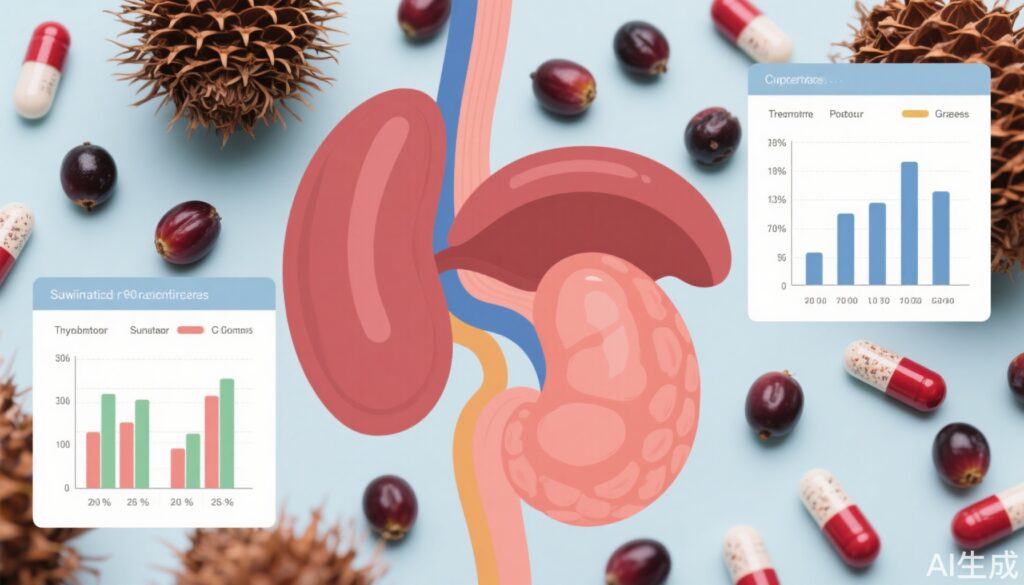Highlights
- Comprehensive evidence shows Serenoa repens is not superior to placebo for improving urinary symptoms or quality of life in men with BPH-related LUTS.
- High-certainty evidence demonstrates no clinically meaningful benefit at both short- and long-term follow-up.
- Adverse event rates are similar between Serenoa repens and placebo.
- The efficacy of combination phytotherapy that includes Serenoa repens remains uncertain and requires further investigation.
Study Background and Disease Burden
Benign prostatic hyperplasia (BPH) is a prevalent, non-malignant enlargement of the prostate gland affecting aging men, most commonly over age 50. BPH can cause lower urinary tract symptoms (LUTS) such as urinary hesitancy, weak stream, nocturia, and incomplete bladder emptying, profoundly affecting quality of life. As the global population ages, the burden of BPH and associated LUTS is increasing, contributing to health care utilization and diminished well-being in older men. While alpha-blockers and 5-alpha-reductase inhibitors are first-line pharmacologic treatments, many patients seek alternative or complementary therapies, including phytotherapy. Serenoa repens (saw palmetto berry extract) is among the most widely used herbal remedies for BPH. Despite its popularity, clinical efficacy has been debated, with earlier studies yielding conflicting results and variable methodological rigor. This article critically reviews the latest high-quality evidence on Serenoa repens for BPH-related LUTS, focusing on the 2023 Cochrane systematic review.
Study Design
The referenced review by Franco et al. (2023) is a systematic review and meta-analysis of randomized controlled trials (RCTs) comparing Serenoa repens with placebo or no treatment in men with BPH and LUTS. The authors conducted a comprehensive literature search of multiple databases (Cochrane Library, MEDLINE, Embase, Scopus, Web of Science, LILACS), clinical trial registries, and grey literature through September 2022, with no language restrictions. Eligible studies included adult men (mean age 52–68 years) with moderate LUTS (International Prostate Symptom Score [IPSS] 8–19), randomized to receive either Serenoa repens, Serenoa-containing phytotherapy, or placebo/no treatment. Outcomes assessed included urologic symptom scores (primarily IPSS), quality of life, and adverse events. Short-term outcomes were defined as up to 12 months, and long-term outcomes as beyond 12 months. Risk of bias and certainty of evidence were rigorously evaluated using established GRADE criteria.
Key Findings
Serenoa repens Monotherapy vs Placebo
– Urologic Symptoms (IPSS): Across nine high-quality RCTs involving 1,681 men, Serenoa repens showed little to no difference in IPSS at short-term follow-up (3–6 months): mean difference (MD) −0.90 points (95% CI −1.74 to −0.07; I² = 68%), with higher scores indicating worse symptoms. This difference is neither statistically nor clinically meaningful, as a change of 3 points or more is generally considered the threshold for clinical relevance.
– Long-term Outcomes: At 12–17 months (3 studies, 898 participants), Serenoa repens had no effect on IPSS (MD 0.07, 95% CI −0.75 to 0.88; I² = 34%), confirming the absence of benefit over time.
– Quality of Life: At short term (5 studies, 1,001 participants), the difference in the IPSS quality of life domain was −0.20 (95% CI −0.40 to −0.00; I² = 39%). At long term (3 studies, 882 participants), MD was −0.11 (95% CI −0.41 to 0.19; I² = 65%). Neither difference reached clinical significance.
– Adverse Events: The risk ratio for adverse events was 1.01 (95% CI 0.77 to 1.31; I² = 18%; 12 studies, 2,399 participants), indicating no increased risk compared to placebo. In practical terms, this equates to 2 additional adverse events per 1,000 men treated (ranging from 38 fewer to 51 more), a negligible difference.
Serenoa repens in Combination Phytotherapy
– Urologic Symptoms: Four studies (460 participants) evaluating combinations of Serenoa repens with other phytotherapeutic agents showed a possible, but uncertain, reduction in IPSS at 12–24 weeks (MD −2.41, 95% CI −4.54 to −0.29; I² = 67%). The certainty of evidence was low, with substantial heterogeneity and imprecision.
– Quality of Life and Adverse Events: Evidence for quality of life was very low certainty and inconclusive, while adverse event rates were similar between groups (RR 0.91, 95% CI 0.58 to 1.41; 4 studies, 481 participants).
Summary Table: Serenoa repens vs Placebo (Short and Long Term)
| Outcome | Short-Term Effect (3–6 months) | Long-Term Effect (12–17 months) | Certainty |
|---|---|---|---|
| IPSS (Symptom Score) | MD −0.90 (−1.74 to −0.07) | MD 0.07 (−0.75 to 0.88) | High |
| Quality of Life (IPSS QoL) | MD −0.20 (−0.40 to −0.00) | MD −0.11 (−0.41 to 0.19) | High |
| Adverse Events (RR) | 1.01 (0.77 to 1.31) | No data | Moderate (short-term) |
Expert Commentary
The findings of this comprehensive review align with prior large-scale studies and major urological guidelines, such as those from the American Urological Association (AUA) and European Association of Urology (EAU), which do not recommend Serenoa repens for BPH due to lack of efficacy. The high-certainty evidence for both symptom and quality of life outcomes strengthens the message that Serenoa repens, despite its popularity and favorable safety profile, offers no clinically relevant benefit for LUTS due to BPH. This is particularly important for clinicians counseling patients attracted to “natural” remedies, as the absence of harm is not a substitute for efficacy.
The modest, uncertain effects seen in combination phytotherapy may warrant further investigation, but heterogeneity in product composition, dosing, and study design currently limit any definitive conclusions. Clinicians should remain cautious and discuss the limitations of these data with patients who inquire about or use such therapies.
Potential mechanisms of Serenoa repens, such as inhibition of 5-alpha-reductase or anti-inflammatory effects, have been demonstrated in vitro but have not translated into measurable clinical benefit. This underscores the importance of robust clinical evidence over mechanistic speculation in guiding therapy.
Conclusion
In summary, the most current and rigorous evidence demonstrates that Serenoa repens does not improve lower urinary tract symptoms or quality of life in men with BPH compared to placebo, and its safety profile is similar to placebo. There is insufficient evidence to support the use of Serenoa repens, alone or in combination, as a therapeutic option for LUTS attributed to BPH. Clinicians should prioritize interventions with proven efficacy and engage in shared decision-making with patients who express interest in phytotherapeutic products. Future research should focus on standardized combinations, well-defined endpoints, and patient-centered outcomes.
References
1. Franco JV, Trivisonno L, Sgarbossa NJ, Alvez GA, Fieiras C, Escobar Liquitay CM, Jung JH. Serenoa repens for the treatment of lower urinary tract symptoms due to benign prostatic enlargement. Cochrane Database Syst Rev. 2023 Jun 22;6(6):CD001423. doi: 10.1002/14651858.CD001423.pub4. PMID: 37345871; PMCID: PMC10286776.
2. Gratzke C, Bachmann A, Descazeaud A, et al. EAU Guidelines on the Assessment of Non-neurogenic Male LUTS, including Benign Prostatic Obstruction. Eur Urol. 2015;67(6):1099-1109.
3. McVary KT, Roehrborn CG, Avins AL, et al. American Urological Association Guideline: Management of Benign Prostatic Hyperplasia (BPH). 2021. Available at: https://www.auanet.org/guidelines-and-quality/guidelines/benign-prostatic-hyperplasia-(bph)-guideline



